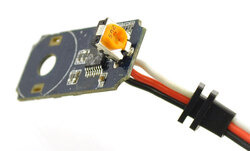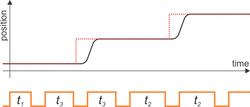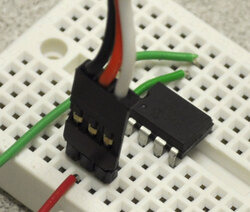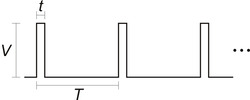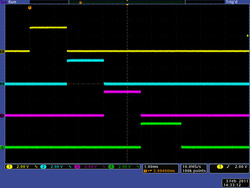Pololu Blog » Engage Your Brain »
Engage Your Brain (Page 7)
A blog by Pololu president Jan Malášek.
Continuous-rotation servos and multi-turn servos
As I discussed in the introduction to servos, one of the consequences of hobby servos’ intended use is that rotation range is limited to about 180 degrees. In this post, I will talk about two exceptions to this general rule: continuous-rotation servos and multi-turn servos. Each of these products loses some features in return for increased rotational range, so none of them are the ideal actuators many would like them to be. There are some specialty servos developed for robot applications that get around the limitations, but those servos are not as standardized and do not really fit into the hobby servo category, so I am not going into any more detail on those beyond mentioning that they exist. Continued…
How an idea becomes a product
The Wixel Shield for Arduino that we released today represents a personal milestone because of what I did not do on it: the shield is the first electronic product made by Pololu that I did not design. That’s not to say I did not have some input on it or that other engineers here did not have substantial contributions to other products, but the Wixel Shield is a first because the basic product concept, the circuit design, and physical implementation (i.e. the PCB layout) were all done by someone else. We also just finished a big facility expansion that was taking up a lot of my attention this year, so I have some more time now to think about our design process and what it takes to go from a new idea to a finished product. Continued…
RC servo speed control
It is often desirable to control the speed and acceleration of hobby RC servos. Understanding your options can be confusing since there are various speeds involved, many similar terms are used, and the terms are not used consistently by different companies or end users. You might also have an idea of what you want your servo to do without knowing what to call it or how to describe it or how to implement it. To get a good understanding of what is going on, it is helpful to picture the position of your servo in relation to the commands you are sending it. A simple first attempt might look like this: Continued…
Advanced hobby servo control using only a timer and interrupts
In this last article about generating pulses for hobby servo control, I will present what I think is the best solution to controlling many servos or controlling some servos while still leaving enough processing time to do other tasks. It’s not that easy to make this approach work well, so my recommendation in most cases is just to get one of our servo controllers, which use this technique. Continued…
Advanced hobby servo control pulse generation using hardware PWM
So far, I have discussed a very simple circuit and a very simple microcontroller approach to generate the control pulses needed to control hobby servos. For some applications, those methods are sufficient, but we often want either to control many servos or to do something in addition to controlling servos, and that is when the limitations of the simple approaches and the demands of the servo interface become more apparent. In this post, I will move on to some more sophisticated techniques to generate servo control pulses. Continued…
Simple microcontroller approach to controlling a servo
Today, I want to discuss the microcontroller equivalent of the simple servo control circuit I presented last time. As I mentioned then, the circuit is about as simple as it can be, yet it requires eight components to arrive at a sub-optimal servo control waveform. Some of its deficiencies, such as the slow rise time of the pulses, can be addressed by slightly more advanced circuits that might implement an astable multivibrator using an integrated circuit such as the famous 555 timer. In terms of part count, the 555-based servo controller might be a bit better than the two-transistor approach, but the 555 has many transistors inside it. As long as we are comfortable categorizing a component with many transistors inside it as a single part, we might as well skip the 555 and go straight to a low pin-count microcontroller, which has thousands of transistors inside it and which will allow us to make a far superior, single-component servo controller. Continued…
Simple hardware approach to controlling a servo
For the last several posts, I have been writing about how hobby servos work and demonstrating the operation of devices made for controlling servos, such as RC receivers and serial servo controllers. That should have given you a good idea of the kinds of control signals we must create if we are to control servos with our own hardware. Today, I am moving on to the subject of controlling servos ourselves, and I will begin with a simple hardware approach. Continued…
Servo control interface in detail
Last time, I gave a basic introduction to the simple pulse interface for sending commands to servos. In this post, I want to explore some of the details and ramifications of the servo interface in a bit more depth. I’ll be using the Mini Maestro 12-channel servo controller, which offers a lot of servo control flexibility, and a current probe with my oscilloscope to illustrate servos’ responses. Continued…
Electrical characteristics of servos and introduction to the servo control interface
So far, I have been talking about servos largely from the perspective of their typical use. While I hope I have provided a decent foundation about their intended use and some idea of what is inside a servo, these are things you could learn from hobby stores and taking apart a few servos. Today, I want to move on to a discussion of the electrical characteristics of servos, with the control interface as the primary topic. From the servo manufacturers’ perspective, the control signal can be an internal detail, so discussing it means we are moving on to a realm that is less officially documented. I will try to keep things general and back up my claims a bit where practical, but some details might not apply to all servos. Continued…
Servo, servo motor, servomotor (definitely not server)
Now that the cat’s out of the bag about RC servos having motors inside (it was a very transparent bag), it’s appropriate to emphasize that servos are not “servo motors” and that “servo” is not short for “servomotor”. Servo is short for “servomechanism”, whereas servo motors are motors intended to be used in servos. It’s important to understand the distinction because we should care about names and communicating well; making the distinction between the terms will also help emphasize why servos are so special. Continued…
